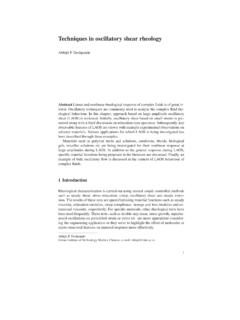Transcription of The Michelson Interferometer - Indian Institute of ...
1 Experiment 4 The Michelson Interferometer1 Experiment 4 The MichelsonInterferometer1 IntroductionThere are, in general, a number of types of optical instruments thatproduce optical interference. These instruments are grouped under thegeneric name of interferometers. The Michelson Interferometer causesinterference by splitting a beam of light into two parts. Each part ismade to travel a different path and brought back together where theyinterfere according to their path length will use the Michelson Interferometer to observe the interferenceof two light sources: a HeNe laser and a sodium lamp.
2 You will studyinterference patterns quantitatively to determine the wavelengths andsplitting of the Na D lines empirically. You will use the HeNe laserinterference spectrum to calibrate the Background -see Hecht, Chap. The Michelson InterferometerThe Michelson Interferometer is a device that produces interferencebetween two beams of light. A diagram of the apparatus is shown inFig. 1. The basic operation of the Interferometer is as follows. Lightfrom a light source is split into two parts. One part of the light travelsa different path length than the other.
3 After traversing these differentpath lengths, the two parts of the light are brought together to interferewith each other. The interference pattern can be seen on a from the source strikes the beam splitter (designated byS).The beam splitter allows 50% of the radiation to be transmitted to thetranslatable mirrorM1. The other 50% of the radiation is reflected tothe fixed mirrorM2. The compensator plateCis introduced along thisExperiment 4 The Michelson Interferometer2 Figure 1: Schematic illustration of a Michelson to make each path have the same optical path length whenM1andM2are the same distance from the beam splitter.
4 After returningfromM1, 50% of the light is reflected toward the frosted glass , 50% of the light returning fromM2is transmitted to theglass screen. At the screen, the two beams are superposed and one canobserve the interference between Interference of Waves With a Single FrequencyIf two waves simultaneously propagate through the same region ofspace, the resultant electric field at any point in that region is thevector sum of the electric field of each wave. This is the principle ofsuperposition. (We assume all waves have the same polarization).
5 If two beams emanate from a common source, but travel over twodifferent paths to a detector, the field at the detector will be determinedby the optical path difference, which we will denote by x=x2 related quantity is the phase difference, , given by =2 x=k x,(1)wherekis the wavenumber. Constructive interference occurs when = 2m ,m= 0, 1, 2, 3,..(2)Destructive interference occurs when = (2m+ 1) ,m= 0,1,2,3,..(3)Experiment 4 The Michelson Interferometer3 Figure 2: Beat signal from two input frequencies into a Michelson Interference of Waves with Two FrequenciesWe will now consider the case of two frequencies with wavenumbersk1andk2that together follow two different paths with a difference of sum of the waves with different amplitudes at pointxalong thex-axis is given by:ET=(eixk1+ei(x+ x)k1)E1+(eixk2+ei(x+ x)k2)E2(4)If we leta=E2/E1and define k= (k1 k2)/2, after a lot of algebra,we can write the intensity (E TET) as.
6 2(1 +a+a2+acos 2 k x+ (1 +a) (cosk1 x+acosk2 x))(5)Figure 2 shows the expected signal, which consists of a fast oscillationas well as a slow oscillation characteristic of 4 The Michelson Interferometer43 ExperimentIn the following experiments, you will calibrate the movement ofM1with the HeNe laser and use the Interferometer to accurately measurethe wavelengths of the fine structure doublet of the sodium D line, aconsequence of the spin of the Calibration with HeNe Laser LightInject the laser beam into the Michelson intererometer.
7 Make sure thebeam is properly retro-reflected. Initially, you will see two bright spotson the screen. Adjust the angle of the fixed mirror until these two spotsoverlap. You can use lenses to expand the beam if , take care when movingM2as the interference is verysensitive to its you translate mirrorM1, you will seefringes appearing and disappearing on the screen. The interferometerlever arm reduction factor is 5X, so that the wavelength of the lightcan be found using =15(2dm)(6)wheredis the distance mirrorM1was moved andmis the number ofrings that disappeared (or appeared) whileM1was being the synchronous motor to facilitate the turning of the microm-eter.
8 As the micrometer is turning, record the interference data withthe computer. The motor runs at rpm and the micrometer moves5 10 4m/rev. This can give you a check of things, but we will usethe HeNe data (look up the HeNe wavelength on the web) to accuratelycalibrate the Sodium LightNow use the sodium lamp to produce an interference pattern. Sincethe spectrum of this light consists primarily of two closely spaced lines(a doublet), each wavelength will produce its own set of fringes. Yourgoal will be to empirically determine 1and 2by measuring the finelyspaced fringes and the beat ismuchmore challenging to get good interference patterns withthe lamps, so take your time and play with alignment, lamp placement,and possible lens placement.
9 You will need to increase the gain in yourdetection should observe both the finely spaced pattern as well as a mod-ulation in the contrast at the difference frequency of the two lines. Yourgoal is to as accurately as possible measure the wavelength of the twosodium lines. Be sure to carefully estimate of the doublet lines of the sodium lamp are not monochromaticExperiment 4 The Michelson Interferometer5due to broadening from pressure effects and motion of the atoms in thelamp (Doppler effect). This means thecoherence lengthis not thatlarge.
10 If the path length difference is too large, you will not see anyfringes. Measure the coherence length of your Interferometer The Michelson Interferometer has also been used to provide evidence for the special theory of relativity, to detect and measure hyperfine structure in line spectra, to measure the tidal effect of the moon on the earth and to provide a substitute standard for the meter in terms of wavelengths of light. Assuming that the given extended source (Sodium vapor lamp) is monochromatic, use eq.





